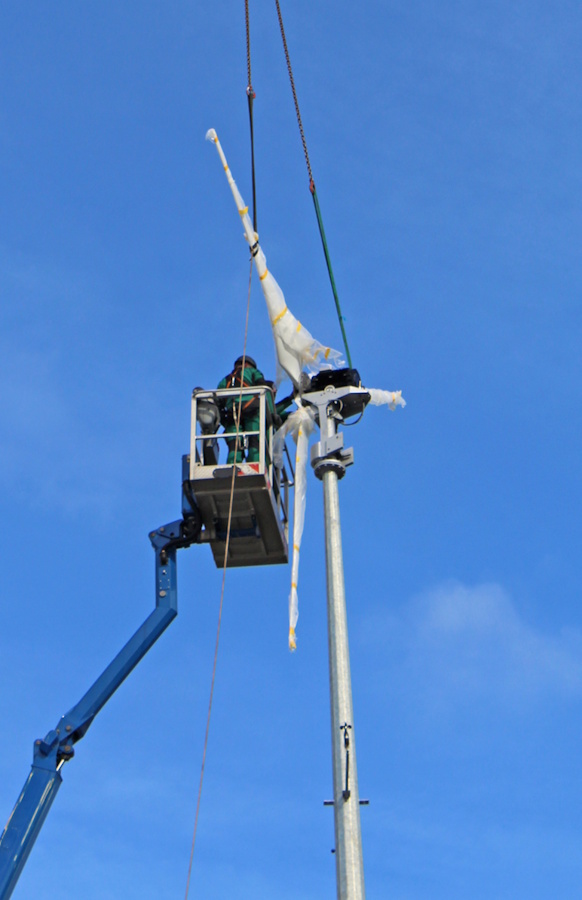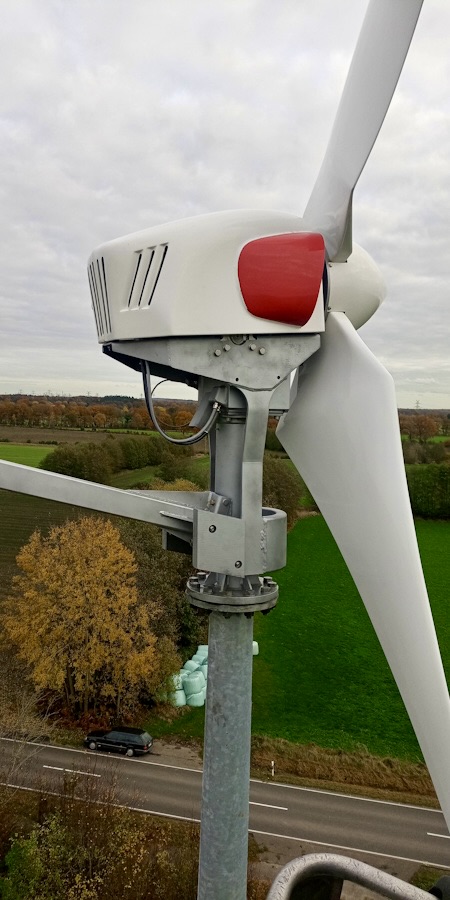Germany’s largest small wind turbine manufacturer comes from Nauroth; Approval problems inhibit expansion; The Middle East relies on small wind turbines.
The topic of wind power is currently occupying the people, the municipal councils and approval authorities in the district of Altenkirchen. When talking about wind power, the average citizen imagines turbines with a total height of almost 200 meters, which shape the landscape of our region from far away and will possibly shape it even more in the future. For Rüdiger Braun, technical manager of BRAUN Windturbinen GmbH from Nauroth, the wind power world looks a little different. Lesser… This is because his “small” wind turbines have an average total height of just 15 – 24 m and the power specifications are not in megawatts, but in kilowatts (2.5 – 9.0 kW). “Small but nice” or “small but mighty” are the appropriate statements about the decentralized energy power plants, which may still have their triumphal march over their big brothers ahead of them.
The start has been made, that much is certain. “But not here in Rhineland-Palatinate,” explains Braun, who puts his finger in the wound of building permits right at the beginning of the company visit by District Administrator Michael Lieber, Mayor Konrad Schwan, Economic Development Officer Berno Neuhoff and Lars Kober from the district administration. “Our state still has a lot of catching up to do compared to other federal states. In Bavaria and Thuringia in particular, the topic of “approval of small wind turbines” is being approached positively. In our country, it is currently almost impossible to obtain a building permit for the construction of a plant. The hurdles under licensing law are too high,” Braun continues. In fact, the construction of a small wind turbine is regulated very differently in Germany. While in some federal states turbines up to a height of ten meters are generally exempt from approval, in other federal states a permit for construction is generally required.
District Administrator Michael Lieber was so convinced of the technology “Made in the Westerwald” that he contacted his building management in the Altenkirchen district administration immediately after the visit. This is now examining whether it is statically possible to integrate such a system on the roof of a district-owned school building. “Small wind technology, which basically has to assert itself on the market without state subsidies, deserves to be brought more into the public focus. Like photovoltaic systems, the use of which is increasingly moving in the direction of self-consumption due to the sharp fall in remuneration rates, small wind turbines can make their contribution to the energy transition as decentralised energy suppliers. It is incomprehensible to me that other federal states support this form of clean energy generation and that plant sales in Rhineland-Palatinate are hardly available. Therefore, I will campaign for the acceptance and expansion of small wind turbines in the state of Rhineland-Palatinate. Because what is possible in Bavaria, Schleswig-Holstein and Thuringia must also be possible on the outskirts of the Westerwald. Regional and district development will deal more closely with the topic in the future and our building management will examine at which other locations the use of wind turbines could be considered,” District Administrator Lieber sums up.
Braun promotes education that should create acceptance. “You have to get away from the image of a buzzing rotor whose shadow creates a disco effect on the neighboring property. As with the large wind turbines, it is important to comply with clear noise and emission values that must not be exceeded,” says Braun, whose export quota is 50 to 60%. In Germany, Bavaria is the largest sales market – according to Braun because of the well-designed legal regulation. The export countries that rely on the small wind turbines are interesting. Instead of heading north, it goes exactly in the other direction. Jordan, Saudi Arabia, and Kuwait, countries where the sun shines, rely on the small wind turbines. “The reason lies in the robustness of our systems. Compared to photovoltaic modules, our wind turbines are not as maintenance-intensive, because the photovoltaic modules would have to be freed from desert sand every day,” says wind power pioneer Braun, who, together with Joachim Fuhrländer, philosophized at the beginning of the 1990s about whether 100 KW turbines could be built. Today, we have reached 70 times the output of a large wind turbine, which feeds its produced energy into the general grid. Currently, there are also inquiries from Japan, Chile (Tierra del Fuego), North and South Korea. But he rebuffed North Korea because of his human and political views.
The focus of small wind technology is on the self-consumption of the energy produced and not on remuneration for the amount fed into the grid, as this is half as low as that of photovoltaic technology. Consequently, the economic efficiency of the plants is not yet given. Rüdiger Braun comments: “My customers are people of conviction who do not have an eye on returns, but are satisfied when clean energy can be produced at the cost of the current household electricity price. In addition, there is the “fun at the facility” aspect, which should not be underestimated. The amount of electricity generation costs is determined on the one hand by the costs of the small wind turbine including inverter and control system and on the other hand by the local wind conditions. If there is a lot of wind, the costs fall, if the wind blows little, the costs rise accordingly. Rüdiger Braun’s right-hand man is his wife Manuela.
She is the managing director of BRAUN Windturbinen GmbH and responsible for the financial matters in the company. Furthermore, she takes care of export processing and customs papers for customers, which are spread around the globe.
The visitor delegation was impressed by the technical know-how that goes into such a system. Anyone who thinks that it is enough to erect a mast and mount a red pole on it is very much mistaken. A large-scale wind turbine in small format, which throttles itself in the event of a strong wind thanks to an intelligent tilting device and even switches itself off in extreme cases. Braun sources the components from the region. For example, Mertens and Schneider from Elkenroth supplies the electrical control system, which also operates a test facility in Elkenroth. The other components installed in the “Antaris” also all come from the Westerwald. “Antaris” derived from “Antares” should mean something to die-hard Star Trek fans, such as Braun himself. He christened his small wind turbine with the name of an Antares Starfleet starship.
The name ANTARIS small wind turbine is now known worldwide and is protected by trademark law together with the logo.




